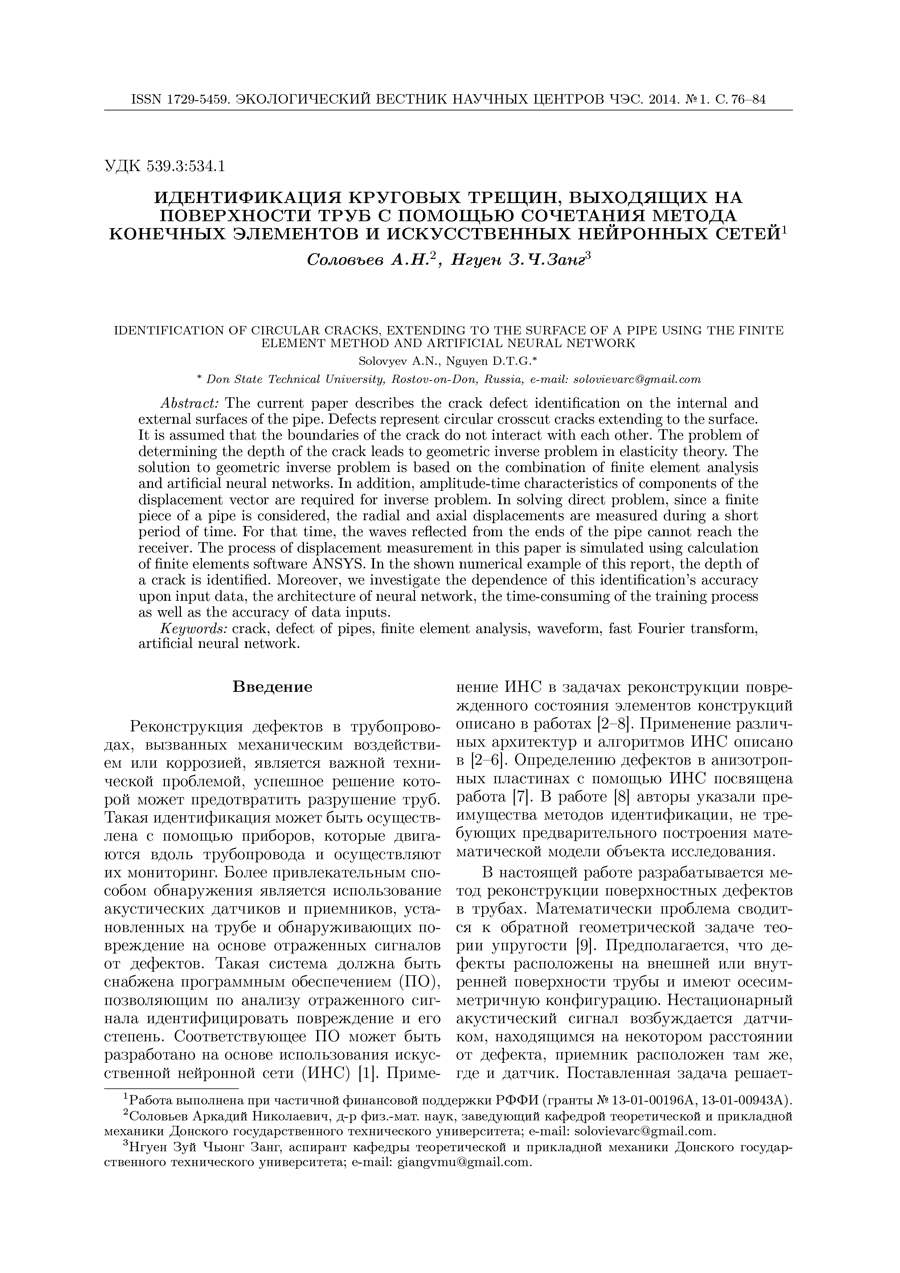Identification of circular cracks, extending to the surface of a pipe using the finite element method and artificial neural network
UDC
539.3:534.1Abstract
The current paper describes the crack defect identification on the internal and external surfaces of the pipe. Defects represent circular crosscut cracks extending to the surface. It is assumed that the boundaries of the crack do not interact with each other. The problem of determining the depth of the crack leads to geometric inverse problem in elasticity theory. The solution to geometric inverse problem is based on the combination of finite element analysis and artificial neural networks. In addition, amplitude-time characteristics of components of the displacement vector are required for inverse problem. In solving direct problem, since a finite piece of a pipe is considered, the radial and axial displacements are measured during a short period of time. For that time, the waves reflected from the ends of the pipe cannot reach the receiver. The process of displacement measurement in this paper is simulated using calculation of finite elements software ANSYS. In the shown numerical example of this report, the depth of a crack is identified. Moreover, we investigate the dependence of this identification's accuracy upon input data, the architecture of neural network, the time-consuming of the training process as well as the accuracy of data inputs.
Keywords:
crack, defect of pipes, finite element analysis, waveform, fast Fourier transform, artificial neural networkAcknowledgement
References
- Haykin S. Neural networks — a comprehensive foundation. Prentice Hall. 1998. 842 p.
- Краснощёков А.А., Соболь Б.В., Соловьёв А.Н., Черпаков А.В. Идентификация трещиноподобных дефектов в упругих элементах конструкций на основе эволюционных алгоритмов // Дефектоскопия. 2011. №6. C. 67-78.
- Waszczyszyn Z., Ziemianski L. Neural networks in mechanics of structures and materials, new results and prospects of applications // Computers and Structures. 2001. Vol. 79. No. 22. P. 2261-2276.
- Соловьев A.H., Курбатова П.С., Сапрунов Н.И., Шевцов С.Н. Об использовании нейронных сетей в задачах определения дефектов в упругих телах. Материалы X международной конференции "Современные проблемы механики сплошной среды". Ростов-на-Дону, 2006. С. 175-180.
- Liu S.W., Huang J. H., Sung J.C., Lee C.C. Detection of cracks using neural networks and computational mechanics // Computer methods in applied mechanics and enginerring. 2002. Vol. 191. P. 2831-2845.
- Khandetsky V., Antonyuk I. Signal processing in defect detection using back-propagation neural networks // NDT&E International. 2002, Vol. 35. No. 7. P. 483-488.
- Xu Y.G., Liu G.R., Wu Z.P., Huang X.M. Adaptive multilayer perceptron networks for detection of cracks in anisotropic laminated plates // International journal of solids and structures. 2001. Vol. 38. P. 5625-5645.
- Fang X., Luo Н., Tang J. Structural damage detection using neural network with learning rate improvement // Computers and Structures. 2005. Vol. 85. P. 2151-2152.
- Ватульян А.О. Обратные задачи в механике деформируемого твердого тела. М.: Физматлит, 2007. 224 с.
- David W. K. A First Course in Fourier Analysis. Cambridge University Press. 2007. 864 p.
- Снеддон И.Н., Берри Д.С. Классическая теория упругости. М.: Наука, 1961. 219 с.
- Красильников В.А., Крылов В.В. Введение в физическую акустику. М.: Наука, 1984. 400 с.
Downloads
Issue
Pages
Submitted
Published
How to Cite
Copyright (c) 2014 Solovyev A.N., Nguyen Z.Z.

This work is licensed under a Creative Commons Attribution 4.0 International License.




